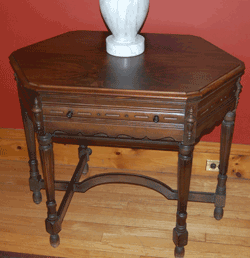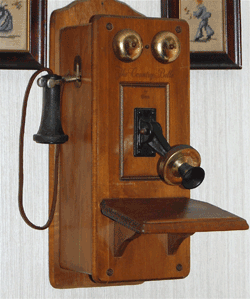What’s It Worth: Radios in disguise
BY STEVE JOHNSON
In the first decade of commercial broadcast radio, the idea of a dual-purpose radio took hold and several companies began to manufacture radios that were as much pieces of furniture (or other appliances) as they were radios. By the 1940s, novelty radios in many forms especially for advertising products or brand names began to appear. By the late 1950s transistorized plastic novelty radios in the shape of just about everything flooded the transistor radio market. In this article we will look at some of the early vacuum tube radios with unique cabinets that may still be found for reasonable prices.

This beautiful table from 1929 hides a seven-tube Atwater-Kent radio chassis and 10-inch speaker.
The earliest tube radio in my collection that falls into this unique category is actually a beautiful antique table manufactured by the Kiel Furniture Company of Milwaukee. Looking at the table you would not know that it hides a seven-tube Atwater-Kent model 55C chassis and 10-inch speaker.
There are two small wooden knobs on the front of the table that look like pulls for a drawer. When the knobs are pulled however, the face of the drawer flips down on hinges to reveal the radio controls, dial, and on/off switch. The wooden top of the table is hinged on the back and lifts for access to the Atwater-Kent radio chassis. The ac power cord and wire for the antenna are hidden from view inside the back legs of the table.
I have found two of these tables with the radio hardware removed. One was found at a yard sale and the other sat in an antique store. Neither owner had any idea the tables were manufactured as a radio cabinet in the late 1920s.

The top of the Atwater-Kent table opens to reveal the radio chassis and speaker.
Most of the Kiel tables I have seen are missing some or all of the radio hardware. I would guess that about two-thirds of the tables I spot have had the radio chassis and speaker removed sometime in the past. I was fortunate to find a complete Kiel table with the original Atwater-Kent radio chassis and speaker still in place at a local auction. In talking with the other bidders about the table after I had won, they were both interested in it as a antique table and were not really interested in the radio.
From a hardware standpoint, the 55C radio chassis used in these tables contains two number 45 tubes, which when tested and working can sell for between $60 and $100 each by themselves.
Pricing at a local auction has typically ranged from $150 to $250 depending on the condition of the table and if it still has the radio hardware installed. I have seen the price almost double that at a few on-line auctions, which I find surprising since shipping these tables with the radio chassis can be expensive. The front door covering the radio controls is usually missing on these tables and it’s near impossible to find a replacement. The hinge design of the flip down door makes it stick almost straight out when open. I’m sure this caused many of the doors to be broken during moves. If the front door is missing it usually cuts the value of the table by at least half.
There is no question the Keil table is a beautiful piece of antique furniture with or without the radio. In fact, it’s one of the few radios in my collection my wife allows in our living room. I have seen several of these tables over the past few years. I haven’t been able to find the number of tables manufactured but I suspect that many survived due more to the high quality table than its value as an antique radio.
Another radio allowed a prominent place in our living space is housed in a grandfather clock cabinet. Several radio companies in the early 1930s including Crosley and Philco housed a radio chassis in a full-size floor-standing clock cabinet.

The 1931 Philco Grandfather Clock and Radio
The 1931 Philco model 270 Grandfather Clock stands 6 feet tall and contains a clock and AM radio powered by 110 Vac. The clock face measures over 9 inches. The radio section contains the Philco model 70 chassis mounted in the mid section with an 8-inch speaker mounted below the chassis. The cabinet has a classic Federal-style look to it.
The original clock in the Philco 270 did not start on its own. The original clock mechanisms had a small wheel on the back of the clock that you spun with your finger to start the clock after it was plugged in. Most of the Philco clocks I have seen have had newer clock motors installed in them.
The Philco model 70 is a fairly common seven-tube Philco chassis that is relatively easy to restore to working condition. If you find a cabinet with the radio chassis missing or beyond repair, a replacement model 70 chassis would not be hard to find.
The most important things consider when contemplating a purchase is the condition of the cabinet, clock face, and hands. Cabinets can be refinished easily as long as all of the original wood and veneer is still intact. Since the radio is fairly easy to rebuild, whether the radio works or not is unimportant. If the radio is working but has not been rebuilt recently for safety concerns, it should at the least be recapped (capacitors replaced) before occasional or daily use unless it’s primarily to look at or for use as just a clock.
Condition is extremely important in placing a value on an original Philco Grandfather Clock. If it is in good restorable condition with the original clock face and hands, expect selling prices to range from $350 to $600 or even higher for a properly restored cabinet and radio. Although I was lucky to find mine for $125, that is not usually the case.
The Philco is a nice piece of furniture. I purchased mine with the intent of rebuilding the radio and reselling it, but when my wife, who loves antiques, saw the clock, it became a permanent fixture in the house.

The 1956 Guild Country Belle
In the mid 1950s, Guild produced several unique tube novelty radios including a cabinet in the shape of a lantern called “The Town Crier,” a radio called “The Spice Chest,” and the “Country Belle,” which looks like a hand-cranked wall phone. These were not the highest-quality radios or cabinets, but they were marketed for their unique style. The Country Belle telephone pictured above has a crank to change stations and knobs for adjusting tone and volume located on the right side. You lift the earpiece off the hook to turn it on. They must have sold well as they are fairly easy to find today. Most of these have little value. It is common to find them in the $35 to $50 range in un-restored condition. Rebuilding the tube radio adds little value to the selling price, although I have seen restored Country Belles sell occasionally at auction in the $100 range.
There are many other examples of vacuum tube radios in unique cabinets. In 1933 Crosley manufactured a tube radio in the shape of a large Coca-Cola bottle. Be prepared to shell out $1,500 to $3,000 if you want one. Be careful though as there is a later copy that sells for less.
Another radio worth mentioning is the “Radiobar,” which appeared in the late 1930s. The Radiobar Company of America, using a Philco chassis, manufactured a series of floor-standing radio cabinets that opened to reveal a bar complete with decanters and glassware. These originally sold for $140 to several hundred dollars. Today a complete Radiobar in good condition with the original glassware can sell for thousands at auction.
For more information about vintage radios and test equipment, you can view some of my collection at StevesAntiqueTechnology.com. ■
Advertisement
Learn more about Electronic Products Magazine





